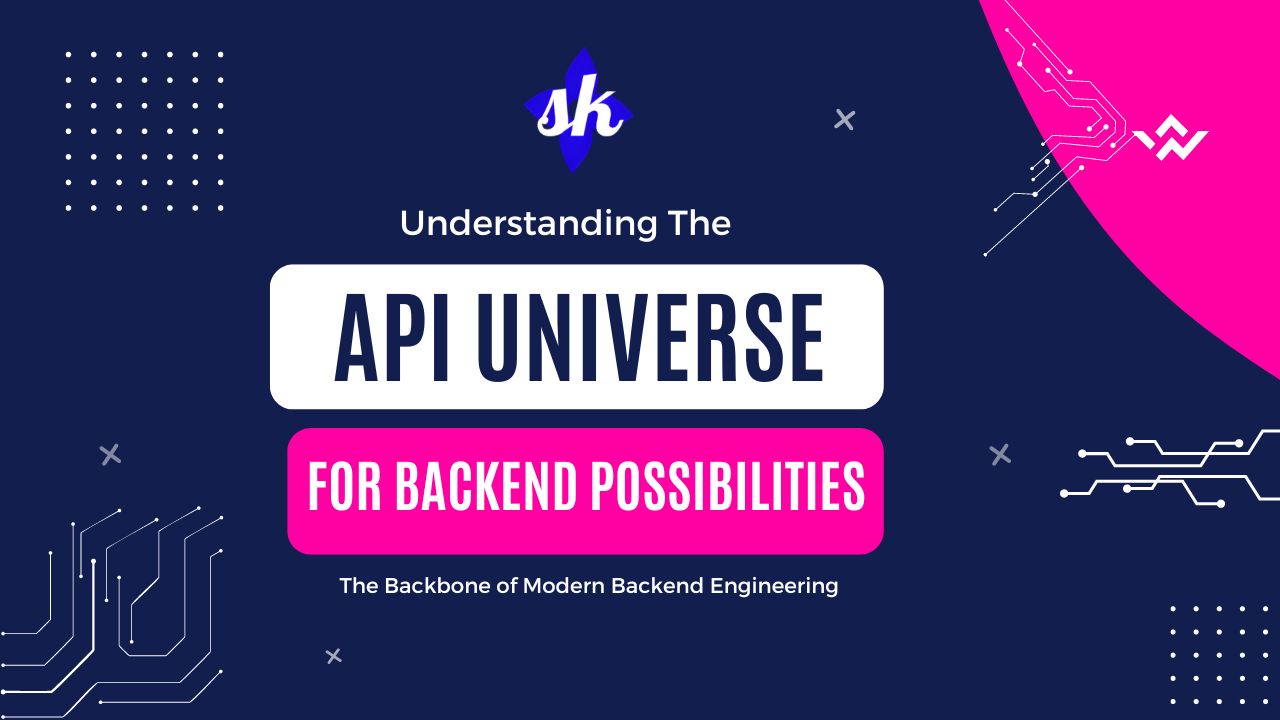Book Appointment Now

Understanding The API Universe
The world of technology is vast and ever-evolving, and at the heart of digital transformation are application programming interfaces (APIs). APIs have become the backbone of modern software development, enabling seamless communication between applications and facilitating the exchange of data and services. In today’s digital age, APIs are everywhere, from apps on your smartphone to the complex systems that power businesses around the world.
What is an API?
API stands for Application Programming Interface, and it is a set of defined rules and protocols that allow different software applications to communicate and exchange data with each other. APIs are a fundamental concept in modern software development, especially in backend engineering, where they play a crucial role in enabling modular and scalable system architectures.
At its core, an API serves as an intermediary layer that abstracts the complexity of a system and provides a well-defined interface for other applications to interact with. It specifies the format and structure of the data that can be exchanged, the available functions or resources that can be accessed, and the protocols and methods for making requests and receiving responses.
Why are APIs important in backend engineering?
Backend engineering involves developing the server-side components of a software application, including the business logic, data storage, and various functionalities that support the front-end or user-facing side of the application. APIs are important in backend engineering for several reasons:
1. Modularity and Separation of Concerns:
APIs promote modular design by allowing the backend system to be broken down into smaller, independent components or services. Each component can have its own API, defining a specific set of functionalities and data it exposes to other parts of the system. This separation of concerns improves maintainability, as changes to one component are less likely to impact others, and it enables parallel development, where multiple teams can work on different components simultaneously.
2. Code Reusability:
APIs encourage code reusability by providing a standardized way to expose and consume functionality. Once an API is defined and implemented, it can be easily integrated into multiple applications or services. For example, a payment processing API can be reused across different e-commerce platforms, or a user authentication API can be utilized by various applications within an organization. This not only saves development time but also ensures consistency and reduces duplication of effort.
3. Scalability and Performance:
APIs facilitate the creation of scalable and performant backend systems. By exposing specific functionalities or data through APIs, backend engineers can optimize the system’s performance. For instance, APIs can implement caching mechanisms to reduce the load on the server, or they can provide rate limiting to control the number of requests made to the server, ensuring the system can handle high traffic efficiently.
4. Integration and Interoperability:
APIs enable seamless integration between different systems and technologies. They provide a common language for communication, allowing applications built with different programming languages or frameworks to exchange data and interact with each other. This interoperability is crucial in modern software development, where systems often need to integrate with external services, legacy systems, or third-party platforms.
Types of APIs
There are several types of APIs commonly used in backend engineering, each serving a specific purpose:
1. RESTful APIs:
Representational State Transfer (REST) is an architectural style for building distributed systems. RESTful APIs adhere to REST principles, such as statelessness, client-server architecture, uniform interface, and cacheability. They use standard HTTP methods (GET, POST, PUT, DELETE, etc.) to perform operations on resources identified by unique URLs. RESTful APIs are widely used due to their simplicity, scalability, and ease of integration with web-based systems.
2. GraphQL APIs:
GraphQL is an open-source query language for APIs that provides a more flexible alternative to REST. Unlike RESTful APIs, where the server defines the available endpoints and data structures, GraphQL APIs allow clients to define the specific data they need. Clients send queries or mutations to the server, requesting only the data they require, which reduces over-fetching or under-fetching of data. GraphQL APIs are particularly useful in complex applications with dynamic data requirements.
3. gRPC APIs:
gRPC (Remote Procedure Call) is a high-performance, open-source framework developed by Google. gRPC APIs use protocol buffers, a language-neutral, platform-neutral mechanism for serializing structured data, to define service interfaces. gRPC supports features like authentication, load balancing, and bidirectional streaming, making it suitable for building distributed systems with efficient, low-latency communication.
4. Web Socket APIs:
Web Socket APIs enable real-time, two-way communication between a client and a server. Unlike traditional HTTP requests, Web Socket connections remain open, allowing data to be pushed from the server to the client instantly. Web Socket APIs are commonly used in chat applications, real-time monitoring systems, or collaborative tools where instantaneous updates are required.
API Design and Documentation
Designing and documenting APIs is an important aspect of backend engineering. Well-designed APIs are intuitive, self-descriptive, and easy to use. Here are a few key considerations in API design:
1. Clear and consistent naming:
Use descriptive and consistent naming conventions for endpoints, parameters, and resources. Clear naming helps developers understand the purpose and functionality of the API without extensive documentation.
2. Well-Defined Parameters and Responses:
Clearly define the expected input parameters, their data types, and the structure of the API responses. This ensures that developers using the API know exactly what data to provide and what format to expect in the responses.
3. Versioning and Deprecation:
APIs should have a versioning scheme to handle changes and updates. When introducing breaking changes, a new version of the API should be released, allowing developers to migrate at their own pace. Deprecated APIs should also be clearly marked, indicating that they will be removed in the future.
4. Comprehensive Documentation:
Provide detailed and up-to-date documentation for your APIs. Documentation should include information about the available endpoints, request/response formats, authentication methods, error handling, and any specific requirements or limitations.
API Security and Authentication
Securing APIs is crucial to protecting sensitive data and prevent unauthorized access. Here are some key considerations for API security:
1. Authentication and Authorization:
Implement robust authentication and authorization mechanisms to ensure only authorized users or applications can access the API. Common approaches include OAuth 2.0, API keys, JSON Web Tokens (JWT), or basic authentication.
2. Input Validation:
Validate and sanitize all input data to prevent security vulnerabilities like SQL injection or cross-site scripting (XSS) attacks. Validate data types, lengths, formats, and ranges to ensure they meet the expected criteria.
3. Rate Limiting:
Implement rate limiting to protect against abuse and distributed denial-of-service (DDoS) attacks. Rate limiting restricts the number of requests a client can make within a specific time frame, preventing malicious or unintended overuse of the API.
4. Encryption and Secure Protocols:
Use secure communication protocols, such as HTTPS, to encrypt data in transit. Additionally, consider encrypting sensitive data at rest, especially when storing confidential information like passwords or personal data.
Testing and Monitoring APIs
Thorough testing and monitoring are essential to ensure the reliability and performance of APIs.
1. Unit Testing:
Write unit tests to verify the functionality of individual API endpoints, ensuring they behave as expected under different scenarios.
2. Integration Testing:
Conduct integration tests to validate the interaction between different API components and external systems. This ensures that the API functions correctly in a real-world environment.
3. Load Testing:
Perform load testing to assess the API’s performance under high traffic and identify potential bottlenecks or scalability issues.
4. Monitoring and Analytics:
Implement API monitoring tools to track the performance, availability, and usage of your APIs in production. Monitoring helps identify issues, optimize performance, and ensure service-level agreements (SLAs) are met.
Conclusion
APIs are a fundamental concept in backend engineering, enabling modular, scalable, and interoperable software systems. By providing a well-defined interface for data exchange and functionality exposure, APIs facilitate collaboration, code reusability, and efficient system design. As a backend engineer, understanding the principles of API design, implementation, and security is crucial for building robust and reliable applications.
Whether you’re working with RESTful APIs, GraphQL, or other API styles, a strong grasp of API concepts will empower you to create seamless integrations, enable innovative use cases, and contribute to the ever-evolving ecosystem of interconnected software applications.




